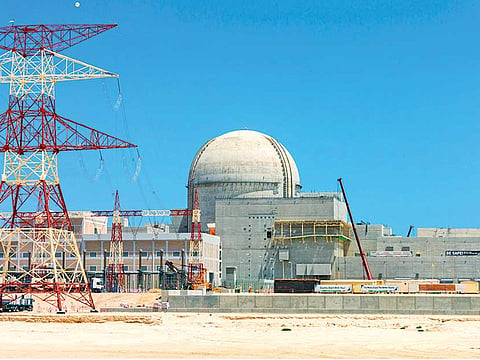First look: Barakah nuclear plant taking shape
Work at site continues to progress with Unit 1 reactor to start operations in 2018

Abu Dhabi: Just five years ago, there was nothing but sand at what is now the site of the Barakah Nuclear Power Plant.
Fast forward to the present and what stands there is the biggest nuclear construction project in the world, as four nuclear reactors take shape and are near completion.
The nuclear site, being built by the Emirates Nuclear Energy Cooperation (Enec), is expected to be fully completed by 2020, with Unit 1 reactor set to become operational in 2018.
Rising demand
The new facility is set to provide the UAE for the first time with electricity from nuclear energy as the country seeks to diversify its energy resources to keep up with rising demand.
Local media on Tuesday were invited for an exclusive, first tour of the Barakah nuclear site, with Enec officials keen to display the continued progress at the site.
“The project started in 2008 and today, fast forward, we see a great achievement. We are all very proud [of the work that has been done],” said Mohammad Al Hammadi, Enec CEO, at a round-table discussion with the press.
“The current progress of Unit 1 is now at 96 per cent, so we are only four per cent from starting the power plant. For the remaining four per cent, all our efforts are going through the quality review of the power plant … to make sure the power plant is built to the specification as per our regulatory requirements,” he added.
“The key message here is that we want to have this power plant meet all the high standards of nuclear safety and quality, and then this power plant will become operational,” he said.
Al Hammadi said that nuclear energy would be a major benefit for the country, not only in terms of generating new sources of electricity, but also for the environment, with more than 20 million tonnes of CO2 being prevented from entering into the atmosphere.
Major role
“The UAE is growing rapidly … This has made the demand for electricity grow. Nuclear energy will play a major role in this equation; we still need gas, renewable energies, and all sources of energy because the country needs to grow,” said Al Hammadi.
“The good thing with nuclear energy from a security stand point is that it is a clean, safe, and a reliable source. When I say clean, I mean there are no CO2 emissions [from nuclear energy]; we will roughly avoid 21 million tonnes of CO2 emissions annually once we have the four units operational,” he added.
Al Hammadi also emphasised that it was important to have more than one source of energy.
“I used to chair the World Economic Forum Global Energy Security Initiative for two years — each country has its own requirements of energy, and for the UAE, it has a beautiful set of energy mix that gives us the flexibility to switch between energy sources in the decades to come,” he said.
Al Hammadi also highlighted that the UAE was sharing its knowledge and experience in the nuclear sector with other countries.
“Currently, the process we have is through the International Atomic Energy Agency (IAEA), which gives us a very clear platform for sharing the lessons we learnt.
“We [also] have cooperation with many countries, and through the IAEA, we conduct workshops on a very frequent basis, sharing our human capital development, our site selection, and technology selection,” he added.
Safety protocols
Al Hammadi also spoke of improving safety regulations at the site after two workers were killed in an accident last year, an incident Al Hammadi termed as “unacceptable”.
“The accident was very unfortunate. What we did after was very comprehensive, we stopped the work completely [at the site] to make sure such a thing never happens again because it is completely unacceptable,” he said.
“We brought in international experts from the field, and we discovered that there was some gaps in the skills, knowledge, and expertise of the workers. So what we did was a very comprehensive training programme for the labourers and construction workers.
“The discipline should never be compromised when it comes to safety,” he added.
Cyber security
On the issue of cyber security, Al Hammadi said the Barakah Nuclear Power Plant has taken all security measures to protect itself against cyber attacks, and that all measures are in line with international standards.
“We have multiple data centres and back-ups. I always say, in the nuclear industry here in the UAE — and this is something I am very proud of — in everything we have done, we have always committed to the highest standards,” he said.
“We have implemented the highest standards of cyber security … which has been adopted [according] to the highest standards globally … We are also working very closely with the National Electronic Security Authority, and so we are continuing to meet the best international standards,” he added.
Timeline and fact file:
The Barakah Nuclear Power Plant
2009: Emirates Nuclear Energy Cooperation launched
2012: Construction work starts at Barakah Nuclear Power Plant, world’s biggest nuclear construction project
2013: Construction work starts for Unit 2 reactor
2014: Unit 3
2015: Unit 4
2017: Unit 1 reactor 96% complete; Unit 2 84% complete, Unit 3 73% complete and Unit 4 49% complete
2018: Unit 1 to become operational
2020: All reactors to be completed
By the numbers
1.4 million cubic yards of concrete used to build the reactors
250,000 tonnes of reinforcing steel used for reactors
20,000 construction workers
5,600 megawatts of electricity to be produced at nuclear power plant
21 million tonnes of CO2 emissions to be avoided
Sign up for the Daily Briefing
Get the latest news and updates straight to your inbox


